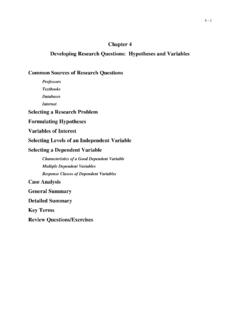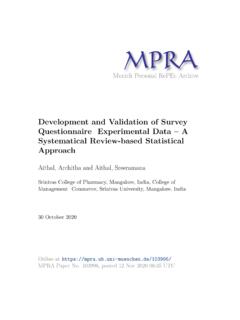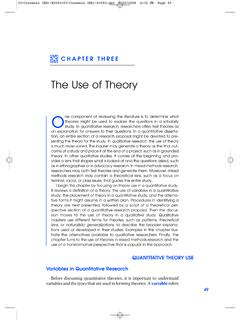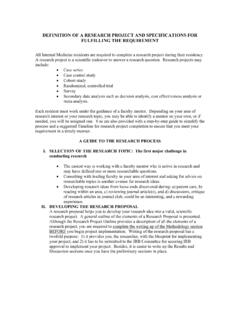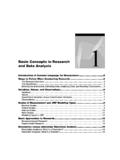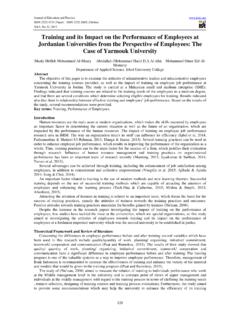Transcription of Developing a Quantitative Data Analysis Plan
1 Developing a Quantitative Data Analysis Plan for Observational Studies Developed by Emily Banks, Ellie Paige and Tanya Mather for the Chronic Disease Epidemiology Group Last updated 25 November 2013. research School of Population Health ANU College of Medicine, Biology &. Environment Developing a Quantitative Data Analysis Plan 2013. Table of Contents Overview .. 3. Principles .. 3. Components .. 3. Background .. 3. 3. Methods .. 4. Planned tables and figures .. 4. Example .. 5. Screen time and 5. Frequently Asked Questions .. 9. General Advice.
2 10. Acknowledgments .. 10. Example Data Analysis Template .. 11. Page 2 of 12. Developing a Quantitative Data Analysis Plan 2013. Overview A Data Analysis Plan (DAP) is about putting thoughts into a plan of action. research questions are often framed broadly and need to be clarified and funnelled down into testable hypotheses and action steps. The DAP provides an opportunity for input from collaborators and provides a platform for training. Having a clear plan of action is also important for research integrity and quality; it guards against data-driven results and allows analyses to be reproduced.
3 The DAP should build on the research protocol and is typically written after the protocol has been developed and before commencing any statistical Analysis . Principles A DAP provides a map of your planned Analysis and Developing this map can assist you to work through, step-by-step, important pieces of information without getting lost. It can help if you can visualise the outcomes of your study: what is the main picture you are trying to convey? What are the main figures/tables that illustrate your outcome? These questions should be clearly addressed in your plan.
4 The DAP end product is a document which is similar to a recipe; it outlines which variables you will be including in the Analysis , and a step-by-step methodology for how you will approach the research questions and hypotheses . As such, it is considered best practice to have a solid DAP. The DAP is a tool that can be used within teams; the level of detail required may differ depending on the team s needs. The exact contents of methods section may depend on your team. The DAP, and in particular the methods section, is iterative and is a living document which should be updated over time.
5 Start with your best idea of what the Analysis will be, though this may change. To assist in Developing an Analysis plan you may need to have a brief look at the data set. This could include doing some basic frequency tables and graphs. Data cleaning also needs to be undertaken. Data cleaning procedures are not covered in this guide but are a very important part of preparing to start data Analysis . Components There are four main components of a DAP: background; aims; methods; and planned (dummy) tables and figures. Each research group may have different expectations of what to include or the level of detail required, but these basic components form a solid base for a DAP.
6 Background The background should present an overview of the relevant literature and a clear rationale for study. The rationale should justify your research questions and your choice of Analysis . When deciding on your approach to the Analysis it is important to look at what has been done in other studies. Aims The study aims and research questions need to be clearly defined and translated into testable hypotheses . The hypotheses are the bridge between the ideas and the data; data will be able to confirm or refute a hypothesis. Page 3 of 12. Developing a Quantitative Data Analysis Plan 2013.
7 Methods The methods section is the main component of the data Analysis plan. The methods should include details on: Data sources Study population: include a definition and outline the inclusion/exclusion criteria Study measures: detail definitions and derivations (including categorisation used, if any) of study measures including: o Main exposure variables o Outcome variables o Other covariates, including potential confounders and mediators Sub-groups: you may wish to examine if the main effect varies by sub-groups of participants. Missing data: Include details about methods used for dealing with missing data (complete case Analysis , coding missing values as separate categories, imputation methods and/or sensitivity analyses).
8 Sensitivity analyses: detail any sensitivity analyses to be undertaken. Sequence of planned analyses including: statistical methods; how hypotheses will be tested; and how potential confounding and bias will be assessed and addressed. The sequence often includes: o Outline of main comparison groups o Frequency and cross-tabulations of main variables o Basic Analysis model (usually age- and sex-adjusted). o Final Analysis model (including adjustment for other confounders). Statistical methods ideally include planned model building approach, methods used to verify statistical assumptions, alternate methods to be adopted in case of violations of assumption and choice significance level.
9 Clinical significance levels would need to be pre-specified, if relevant. Analysis software: outline the software and version number you will be using for the Analysis . Planned tables and figures Planned tables and figures (also called dummy tables) are basically an outline of a table or figure which will used to present the result. The dummy table has empty cells which are to be populated after the data Analysis . The planned tables and figures bring into focus of what you are doing and how you will display your results. Planned tables and figures can also be a useful talking point for discussing the analyses with collaborators and allow for refinement of your research intentions.
10 Further, the planned tables and figures can be copied directly into the results section of a paper or chapter and the cells populated after Analysis . Page 4 of 12. Developing a Quantitative Data Analysis Plan 2013. Example Screen time and obesity 1. Background increasing sedentary time, especially screen-time obesity a mounting public health problem increasing obesity with increasing screen-time already observed focus on episodic physical activity but suggestion that total activity more important lack of evidence regarding screen-time/obesity relationship in different population subgroups 2.

